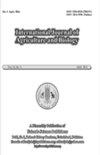Interference of Herbicides in Association of Diazotrophic Bacterium Nitrospirillum amazonense and Sugarcane Pre-Sprouted Seedlings
Q2 Agricultural and Biological Sciences
引用次数: 0
Abstract
Microbial inoculant containing cells of Nitrospirillum amazonense is a recent technology that has been used in association with pre-sprouted seedlings to sustainably increase the productivity of sugarcane. This study aimed to assess the sensitivity of the rhizobacterium N. amazonense to the herbicides imazapic and indaziflam and the effect of this inoculation and herbicide treatments on sugarcane pre-sprouted seedlings. The In vitro sensitivity of the N. amazonense to the herbicides was assessed using the minimum inhibitory concentration technique (first assay). In this research, we evaluated imazapic (200 g a.i. ha-1) and indaziflam (100 g a.i. ha-1) at five doses: recommended dose (1×D), twice the recommended dose (2×D), one and a half of the recommended dose (1.5×D), half the recommended dose (0.5×CD), a quarter of the recommended dose (0.25×CD) and control treatment. The sensitivity of N. amazonense to imazapic and indaziflam applied at commercial doses on autoclaved soil was assessed in the second assay. The bacterial population count was performed using the most probable number technique (McCrady Table). The third assay assessed five herbicide treatments (clomazone (720 g a.i. ha−1), imazapic (200 g a.i. ha−1), tebuthiuron (800 g a.i. ha−1), indaziflam (75 g a.i. ha−1), sulfentrazone (800 g a.i. ha−1) and control without herbicide) applied in pre-planting of pre-sprouted seedlings of the variety RB 966928 in the presence and absence of the inoculant N. amazonense. The results showed that the presence of indaziflam did not interfere with the In vitro growth of the bacterium N. amazonense, regardless of the dose. Imazapic caused significant inhibition of bacterial In vitro growth from the recommended dose (200 g a.i. ha-1). The N. amazonense count in the soil of treatments that received indaziflam and imazapic application did not differ compared to the soil without herbicide. The pre-sprouted seedlings of the variety RB966928 showed high sensitivity to the herbicide imazapic, regardless of N. amazonense inoculation. Clomazone, tebuthiuron, and sulfentrazone did not interfere with the growth-promoting effect of N. amazonense. The results showed that the recommended dose of the herbicides tested does not impair the growth promoting effect of N. amazonense, and the inoculation of the pre-sprouted seedlings does not alter their sensitivity to herbicides, although the selectivity of the seedlings is differential among herbicides. Therefore, it may be concluded that the combined use of these technologies is a viable alternative to increase sugarcane productivity in a more sustainable way. © 2022 Friends Science Publishers除草剂对重氮营养细菌亚马孙硝化螺旋菌与甘蔗预芽苗关联的干扰
含有亚马逊氮螺菌细胞的微生物接种剂是一项最新技术,已与发芽前的幼苗结合使用,以可持续地提高甘蔗的生产力。本研究旨在评估根际细菌N.amazonese对除草剂imazapic和indaziflam的敏感性,以及这种接种和除草剂处理对甘蔗发芽前幼苗的影响。使用最小抑制浓度技术(第一次测定)评估了N.amazonese对除草剂的体外敏感性。在这项研究中,我们评估了五种剂量的伊玛扎匹克(200 g a.i.ha-1)和吲唑福林(100 g a.i.ha-1):推荐剂量(1×D)、推荐剂量(2×D)的两倍、推荐剂量的1.5×D的1.5倍、推荐量的0.5×CD的一半、推荐剂量四分之一(0.25×CD)和对照治疗。在第二次测定中评估了N.amazonese对在高压灭菌土壤上以商业剂量施用的imazapic和indaziflam的敏感性。使用最可能数技术(McCrady表)进行细菌种群计数。第三次试验评估了在有无接种剂N.amazonese的情况下,在品种RB 966928的预发芽幼苗的预种植中应用的五种除草剂处理(氯马宗(720 g a.i.ha−1)、伊玛扎匹克(200 g a.i.ha−1。结果表明,无论剂量如何,吲唑福明的存在都不会干扰细菌N.amazonese的体外生长。Imazapic在推荐剂量(200 g a.i.ha-1)下对细菌体外生长产生显著抑制。与未使用除草剂的土壤相比,使用吲唑福明和伊玛扎普处理的土壤中亚马逊N.amazonese含量没有差异。品种RB966928的预发芽幼苗对除草剂伊玛扎匹克表现出高敏感性,无论是否接种亚马逊农杆菌。Clomazone、tebuthiuron和sulfuentrazone不干扰N.amazonese的促生长作用。结果表明,推荐剂量的除草剂不会削弱亚马逊宁的促生长作用,接种预发芽幼苗不会改变其对除草剂的敏感性,尽管不同除草剂对幼苗的选择性不同。因此,可以得出结论,综合使用这些技术是以更可持续的方式提高甘蔗生产力的可行替代方案。©2022 Friends Science出版社
本文章由计算机程序翻译,如有差异,请以英文原文为准。
求助全文
约1分钟内获得全文
求助全文
来源期刊

International Journal of Agriculture and Biology
AGRICULTURE, MULTIDISCIPLINARY-
CiteScore
1.70
自引率
0.00%
发文量
40
审稿时长
5 months
期刊介绍:
Information not localized
 求助内容:
求助内容: 应助结果提醒方式:
应助结果提醒方式:


